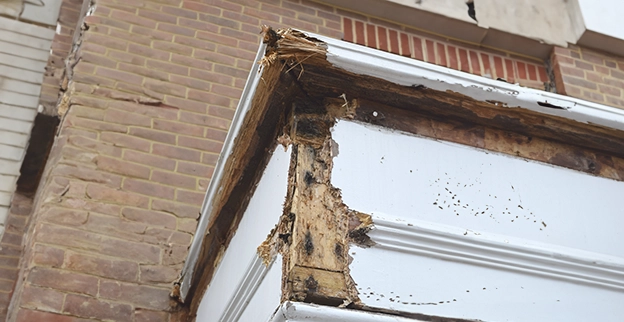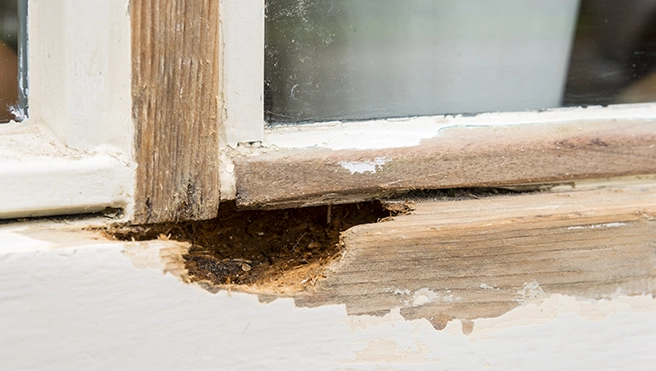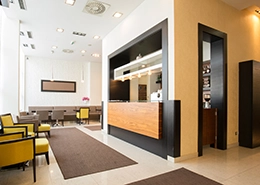Mr. Handyman of West Hartford, S Windsor, and Newington offers effective solutions and repair services for all your wooden surfaces. Our service professionals have a dedication to quality services and complete customer satisfaction. You are our top priority. Our specialty lies in addressing wood decay resulting from water damage, bacteria, and pests.
Discover the extensive services for wood rot repair in West Hartford, CT, by Mr. Handyman and acquire the knowledge to effectively resolve any rot issues just in time for the upcoming patio season!
Our Expert Services for Wood Rot Repair: West Hartford, CT
A spacious wooden deck exudes aesthetic appeal and offers an excellent environment for social gatherings and immersive reading. However, the impeded threat of wood rot falls heavy, and could ultimately compromise the integrity of your deck's frame. But with Mr. Handyman's professional services, we'll have your deck repaired and protected from wood rot. Excessive moisture from severe weather conditions leads to the growth of fungi in wood, resulting in wood rot. Like all forms of mold, it starts small and vastly spreads in the right conditions. Here are some of the signs you may need wood rot repair in West Hartford, CT:
- Discoloration and darker-colored timber
- Damp, musty odor
- Soft, spongy or crumbly texture
- Peeling or flaky paint
- Splintering and fissures
- Shrinkage
- Small holes and leakages
If you are noticing these signs, don't hesitate to contact Mr. Handyman if you see these signs. It's always better to be proactive instead of reactive!
We Offer These Types of Wood Rot Treatment in West Hartford, CT
Damp wood eventually turns into rotten wood, and there are various types of wood decay fungi that can affect both dead wood, also known as brown rot, and living trees. Fungal migration requires an abundance of moisture around the fiber saturation point. The wood rot that can impact your home is classified into three categories. Let's take a look.
Brown Rot/Dry Rot
Brown wood rot, also referred to as dead wood rot, occurs when fungi infiltrate wood and disrupt its cellulose content, resulting in a gradual deterioration process. As a consequence, the affected wood cracks, splits and turns dry and brittle. Distinguished by its reddish-brown hue, this particular decay fungus disintegrates the wood into small fragments resembling cubes. Seek immediate wood rot repair if you notice brittle, dark wood with deep cracks. Exposure to brown rot fungal spores can cause wood structures, such as subfloors and decks, to deteriorate in West Hartford, CT.
Brown rot's fungal growth is puffy, white, and wispy, and it just so happens to be contagious. If left unchecked, wood rot can quickly spread from one area of your home to another. Furthermore, it has the ability to mutate and regenerate once it consumes the timber. Therefore, simply hoping for it to disappear is not a viable solution. It is crucial to address this issue promptly and seek professional wood rot repair in West Hartford, CT.
White Rot
Lignin, a natural polymer found in wood, plays a crucial role in providing wood with its inherent strength and structure. However, when certain types of fungi consume lignin, it not only removes the color of the wood but also transforms its texture into a delicate and spongy state, leading to what is known as white rot. This destructive phenomenon can affect both live and dead trees but is predominantly observed in softwoods. Areas with high levels of moisture or excessive dampness are particularly prone to white rot. Fortunately, combating this issue involves employing specific rot treatments, such as employing fungicides to eliminate the fungus or mold, followed by the replacement of the affected wood.
Soft Rot
Soft rot is a type of decay that moves at a slower pace compared to white and brown rot. It possesses a stealth-like quality, silently infiltrating the cellulose and lignin in wood cells, mercilessly devouring everything in its path and leaving behind a honeycomb-like structure. Although it is the least common form of mold, soft rot is often discovered in extremely hot or freezing environments, whereas brown and white rot typically originate within the inner depths of the wood. Treating soft rot usually involves the removal and replacement of the affected materials with new, treated timber, or the application of a preservative to eliminate the mold and prevent future deterioration.
The Process: Wood Rot Repair West Hartford, CT
In order to effectively address issues with wood rot, it is vital to prioritize professional services for wood rot repair in West Hartford, CT. Finding and addressing the root cause of water damage is crucial prior to commencing any repair work. Swiftly halting the source of the water damage is of utmost importance. Failure to do so will only result in repeated occurrences of the problem. Though it is possible to contain the damage and treat the affected areas, it is highly advisable to proactively identify and resolve the underlying issues that initiated the problem in the first place.
You can effectively halt the spread of wood rot by treating the affected wood with a high-quality fungicide. However, in severe cases of wood rot, complete replacement of the affected wood may be necessary. Our professionals utilize fungicides during the wood rot treatment in West Hartford, CT, specifically during the crucial drying-out phase. The fungicide is readily available as both a concentrated formula and a convenient, ready-to-use product. It is typically applied using either a brush for precision or a sprayer for broader coverage.






